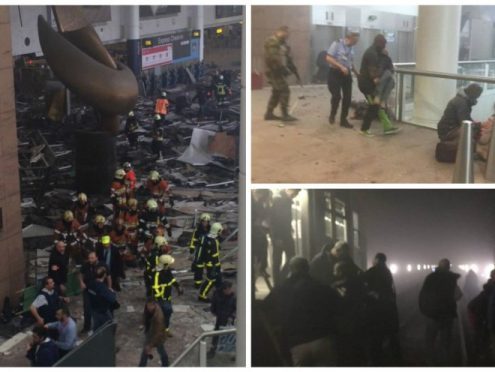Islamic State has claimed responsibility for the deadly terror attacks in Brussels this morning, according to a news agency close to the group.
At least 34 people have been killed and nearly 200 injured as terrorists inflicted a new outrage on a European capital.
Coordinated bomb attacks on the main airport and Metro system in Brussels left a major city in lockdown once again less than five months after Paris was hit by a wave of deadly strikes.
The AMAQ agency, which is affiliated to the jihadist organisation, said: “Islamic State fighters carried out a series of bombings with explosive belts and devices on Tuesday, targeting an airport and a central metro station in the centre of the Belgian capital Brussels.”
It added: “Islamic State fighters opened fire inside Zaventem Airport, before several of them detonated their explosive belts, as a martyrdom bomber detonated his explosive belt in the Maalbeek metro station.”
The atrocities on Tuesday, condemned as “blind, violent and cowardly” by Belgian prime minister Charles Michel, came after the arrest last week of terror mastermind Salah Abdeslam, who plotted November’s massacre in the French capital.
Security was being stepped up at major transport hubs around the continent, with British police forces boosting numbers at “key locations” including ports, airports and the rail network.
French prime minister Manuel Valls said: “We are at war. In Europe we have been subjected to acts of war for several months.”
A suicide bomber struck first near the American Airlines desk at Brussels airport, with local media reporting that shots were fired amid shouting in Arabic. A US official claimed a suitcase bomb was also detonated.
The explosion on the Metro was near European Union buildings and the US embassy.
First news of the attacks came when the airport was rocked by a double blast around 7am UK time. The attack on the Metro came about an hour later.
Jef Versele, 40, from Ghent, told the Press Association: “I was on my way to check in and two bombs went off – two explosions.
“I didn’t see anything. Everything was coming down. Glassware. It was chaos. It was unbelievable. It was the worst thing.”
Footage from inside the airport building showed a scene of devastation with ceiling tiles strewn across the floor and suitcases abandoned.
Images of passengers climbing from a Metro train into a smoke-filled tunnel near Maelbeek station were reminiscent of scenes following the July 7 attacks in London.
Other images showed the injured from the Metro being treated in the street, while at the airport people could be seen fleeing in terror in video footage shot from an airport car park.
As the army was deployed and the transport system was locked down, Mr Michel said: “In this tragic and dark moment for our country, more than ever I call everyone to show calm but also solidarity.
“We are faced with a challenge, a difficult challenge, and we have to face this challenge being united, showing solidarity and being together.”
International leaders united in support for Belgium, with David Cameron branding the atrocities “appalling” and US president Barack Obama condemning the “outrageous attacks against innocent people”.
